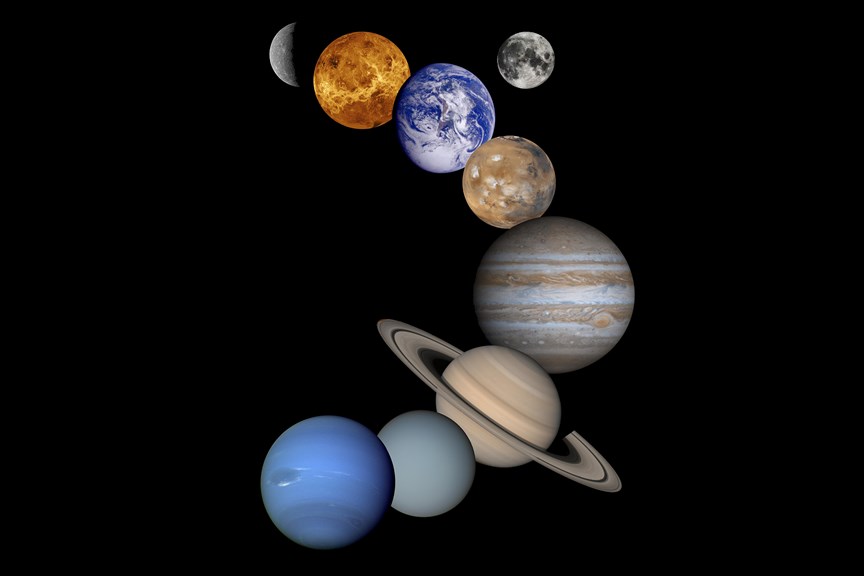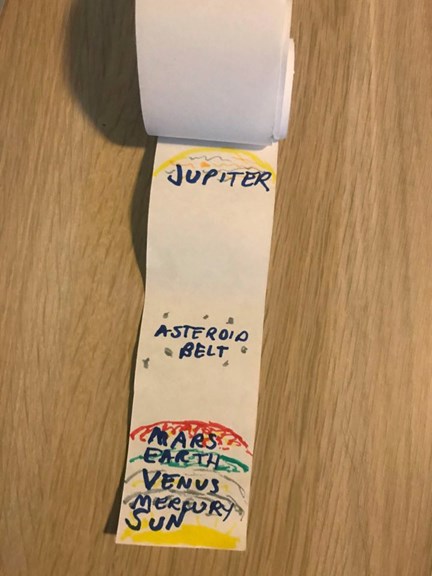The Solar System in your pocket
How close is Earth to the Sun? How far are we from Pluto? This activity will have you creating a paper model of the distances in our Solar System that you can pop in your pocket.
Our Solar System is made up of eight planets and many other objects such as moons, asteroids and comets orbiting the Sun. We have the inner, rocky planets of Mercury, Venus, Earth and Mars, followed by an asteroid belt. Further out are the gas giants Jupiter and Saturn and the icy Uranus and Neptune. At the farthest reaches of our Solar System we find the Kuiper Belt, a large region beyond Neptune made up of icy objects, rocks and Dwarf planets including Pluto! We are going to make a scale model to show how far away the planets would be from the Sun and each other, if the entire solar system were shrunk down to one metre across! Your model will show the planets lined up so you can see them all at once instead of scattered around the Sun along their orbits.
- Get a strip of paper about a metre long. You may need to tape some strips together to get it long enough. A roll of party streamer works well too. You will also need a texta or pencil.
- Label one end of your strip of paper with the word Sun and the other end “Kuiper Belt”.
- Fold your paper in half, crease the fold and draw a mark on that centre point. Which Planet do you think might be halfway between the Sun and the Kuiper Belt? It’s Uranus, so you can write that on the centre point.
- Refold the paper in half, then fold it in half again and crease them so you now have folds at the quarter points. Unfold then label the fold in between the Sun and Uranus as Saturn and the fold between Uranus and the Kuiper belt as Neptune.
- Fold the Sun to meet Saturn, unfold and now mark that spot as Jupiter.
- Fold the Sun to meet Jupiter, unfold and mark that spot with “Asteroid Belt”
- Fold the Sun to meet the Asteroid Belt, unfold and mark that spot as Mars. Phew! Only 3 planets to go.
- Fold the Sun up to meet the line for Mars. Leave it folded and fold that section in half. Unfold the tape and you should have three creases. Mark Earth on the crease nearest Mars, Venus on the middle crease and Mercury on the crease closest to the Sun.
- To complete your Pocket Solar System you can print and cut out the planets and stick them over the label or draw them yourself! Roll up your finished piece of paper and you have yourself a pocket Solar System!
Earth and the other planets in the inner solar system are relatively close together, compared with the planets that lie beyond the asteroid belt in the outer solar system. While it may seem like Neptune is far from our Sun, on this scale, the nearest star to our Solar System Proxima Centauri would be about 7 kilometres away. It’s also important to note that at this scale our Sun would be smaller than a grain of sand and you couldn’t see any of the planets without a magnifying glass!
Our Scienceworks challenge
There are still many other objects in our Solar System. Perhaps you can add in our Moon and the moons of Jupiter. What about spacecraft or other dwarf planets?








